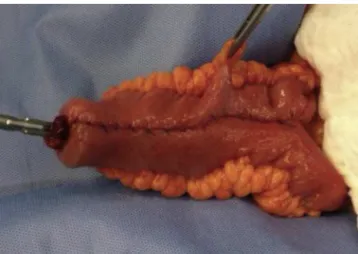w w w . j c o l . o r g . b r
Journal
of
Coloproctology
Original
Article
Surgical
complications
and
metachronous
rectal
cancer
risk
in
patients
with
classic
familial
adenomatous
polyposis
Paulo
Roberto
Stevanato
Filho
∗,
Samuel
Aguiar
Jr.,
Fábio
O.
Ferreira,
Wilson
T.
Nakagawa,
Ranyell
M.
Spencer,
Renata
M.
Takahashi,
Tiago
S.
Bezerra,
Ademar
Lopes
ColorectalTumorNucleus,PelvicSurgeryDepartment,A.C.CamargoCancerCenter,SãoPaulo,SP,Brazil
a
r
t
i
c
l
e
i
n
f
o
Articlehistory:
Received28October2014 Accepted15November2014 Availableonline28January2015
Keywords:
Familialadenomatouspolyposis Colorectalcancer
Totalcolectomy Adenomatouspolyps Restorativeproctocolectomy
a
b
s
t
r
a
c
t
Introduction:Familialadenomatouspolyposis(FAP),anautosomaldominantdisease char-acterizedbydevelopmentofnumerousadenomatouspolypsinthecolonandrectum,is causedbygermlinemutationsintheAdenomatousPolyposisColi(APC)gene.
Methods:Todetermine thesurgical morbidityin patientswithclassical familial adeno-matouspolyposisanddeterminetheincidenceofmetachronouscolorectalcancer(CRC)in thoseundergoingtotalcolectomy(TC)withileorectalanastomosisorrestorativetotal proc-tocolectomy(TPC)andilealpouchanalanastomosis.Weanalyzedpatientswithfamilial adenomatouspolyposiswhoreceivedtreatmentandregularfollow-upattheA.C.Camargo CancerCenterfrom1994to2013.
Results:Operativecomplicationsoccurredin22patients(34.3%),16(25%)beingearly compli-cationsand8(12.5%)latecomplications.Nomortalityoccurredasaresultofpostoperative complications.Theincidenceofmetachronousrectalcanceraftertotalproctocolectomy was2.3%andaftertotalcolectomy18.18%(p=0.044).
Conclusions:In order to provide betterquality oflife for individuals with familial ade-nomatouspolyposis,total colectomy is commonlyoffered, asthis simpletechnique is traditionallyassociatedwithlowerratesofpostoperativecomplicationsandbetter func-tionaloutcomes.However,ithasbecomealessattractivetechniqueinpatientswithfamilial adenomatouspolyposisinitsclassicalordiffuseform,sinceithasasignificantlyhigher probabilityofmetachronousrectalcancer.
©2015SociedadeBrasileiradeColoproctologia.PublishedbyElsevierEditoraLtda.All rightsreserved.
∗ Correspondingauthor.
E-mail:paulorstevanato@gmail.com(P.R.StevanatoFilho).
http://dx.doi.org/10.1016/j.jcol.2015.01.006
Complicac¸ões
cirúrgicas
e
risco
de
câncer
retal
metacrônico
em
pacientes
com
polipose
adenomatosa
familiar
clássica
Palavraschave:
Poliposeadenomatosafamiliar Câncercolorretal
Colectomiatotal Póliposadenomatosos Proctocolectomiarestaurativa
r
e
s
u
m
o
Introduc¸ão: Poliposeadenomatosafamiliar(PAF),umadoenc¸aautossômicadominante car-acterizadapelaformac¸ãodenumerosospóliposadenomatososnocólonereto,écausada pormutac¸õesdalinhagerminativanogenedapoliposeadenomatosadocólon(PAC). Métodos: ParadeterminaramorbidadecirúrgicaempacientescomPAFclássicae determi-naraincidênciadecâncercolorretal(CCR)metacrôniconaquelespacientessubmetidosà colectomiatotal(CT)comanastomoseíleo-retalousubmetidosàproctocolectomia restau-rativa(PCT)eanastomosebolsaileal-anal,foramanalisadospacientescomPAFqueforam tratadosetiveramacompanhamentoperiódiconoA.C.CamargoCancerCenterde1994até 2013.
Resultados: Ocorreramcomplicac¸õescirúrgicasem22pacientes(34,3%);16(25%)tiveram complicac¸õesprecocese8(12,5%)complicac¸õestardias.Nãohouvemortescomoresultado decomplicac¸õespós-operatórias.AincidênciadecâncerderetometacrônicoapósPCTfoi de2,3%eapósCTfoide18,18%(p=0,044).
Conclusões: AfimdeproporcionarmelhorqualidadedevidaparaospacientescomPAF, CTécomumenteoferecida,poisestatécnicasimplesestátradicionalmenteassociadacom menorespercentuaisdecomplicac¸õespós-operatóriasemelhoresresultadosfuncionais. Noentanto,CTsetornouumatécnicamenosatraenteempacientescomPAFemsuaforma clássicaoudifusa,umavezquetrazconsigoumaprobabilidadesignificativamentemaior decâncerretalmetacrônico.
©2015SociedadeBrasileiradeColoproctologia.PublicadoporElsevierEditoraLtda. Todososdireitosreservados.
Introduction
Familialadenomatouspolyposis (FAP), anautosomal domi-nantdiseasecharacterizedbythedevelopmentofhundredsto thousandsofadenomatouspolypsinthecolonandrectum,is causedbygermlinemutationsintheAdenomatousPolyposisColi (APC)gene,whichisinchromosomalregion5q21-22.1,2 This mutationispresentin1in10,000livebirths,andaccountsfor 1%ofthecasesofcolorectalcancer(CRC).3
Inclassicalpolyposispolyps,mainlyinthedistalcolon (rec-tosigmoid),oftendevelopduringchildhoodandincrease in sizeandnumberinadolescence,whentheycharacteristically developthroughoutthecolon.Halfofthesepatientsdevelop adenomasbytheageof15yearsand95%bytheageof35.1 Genomicpenetranceisapproximately100%.Themedianage ofdiagnosisofCRCis39years;however,7%ofpatientsdevelop CRCbeforetheageof21.
EssentialstepsinthemanagementofpatientswithFAP includeearlydiagnosisofaffectedindividuals,performance ofprophylacticcolectomy whenappropriate,genetic coun-seling,recognitionofvariousextracolonicmanifestationsand adequatepostoperativefollow-up.1
Surgeryis the mosteffective means ofpreventing CRC, mainlyintheformoftotalcolectomy withileorectal anas-tomosis(IRA)ortotalproctocolectomy(TPC)followedbyileal pouchandileoanalanastomosis.4Preservationoftherectum isassociatedwithbetterfunctionaloutcomesandless mor-bidity,butcarriesariskofmetachronoustumorinthestump remnant.5,6Decisionsconcerningthebestprocedureforeach patientshouldbebasedonfactorssuchasage,locationand
numberofpolyps,location ofgeneticmutationandpatient acceptanceofundergoingregularpostoperativefollow-up.
Until 1980,prophylacticrestorativeproctocolectomyand ilealpouchanalanastomosiswastheprocedureofchoicefor thetreatmentofFAP.Thereafter,TPCfollowedbyilealpouch andileoanalanastomosisbecamethegoldstandardfor treat-mentoftheclassicordiffuseformofthisdisease.3
Ourobjectivesweretoassesssurgicalmorbidityinpatients withclassicalFAPandascertaintheriskofmetachronousCRC intheanorectalregioninpatientswhohadundergoneTCwith IRAorTPCwithilealpouch,thesebeingthemostcommonly performedproceduresinmostinstitutions.
Patients
and
methods
Relevantdataofpatients withFAP whowere added tothe hereditaryCRC registryofthe A.C.CamargoCancer Center (HACC)from1994to2013wereretrospectivelyanalyzed.The diagnoses of FAP had been established by clinical history andcolonoscopywithhistologicalanalysisofsomeresected polyps.
34 FAP families (620 individuals in 4 generations)
104 individuals with colorectal cancer
67 deaths from colorectal cancer
• 02 lost to follow
• 06 patients with attenuated FAP
• 04 others who were not operated
• 10 patients underwent another surgical method or purpose
64 with classic FAP analyzed
– 42 restorative proctocolectomy and ileal pouch anal anastomosis (TPC)
– 22 total colectomy with ileorectal anastomosis (TC)
183 patients with FAP
86 patients - Follow in HACC
Fig.1–Selectionofpatientsforthestudy.
asweresixwithattenuatedFAPandfourotherswhorefused toundergopreventivesurgicaltreatment.Oftheremaining64 patients,42underwentTPCand22TC(Fig.1).
ForTC,approximately15cmofrectumwaspreserved, fol-lowedbyperformingprimaryIRAend-to-endwitha29mm circularstapler.TPCconsistedofresectionofthecolonand rectum,followedbyreconstructionofameansofintestinal transitwithamechanicalbowelanastomosisbyadouble sta-plingtechniqueinvolvingfashioningan15cm ilealJ-pouch usingtwostaplingsof75mmandanastomosingthispouchto theanal canalwitha29mmcircular stapler.Inthese, pro-tectiveileostomywasperformed andalsoroutinedrainage (Fig.2).
Fig.2–IlealJ-pouchwith15cmextension,fashionedwith mechanicalsuturesandplacementofthepointedarchof thestaplerforileoanalanastomosis(pouch–anus)bya doublestaplingtechnique.Restorativeproctocolectomyand ilealpouchanalanastomosisinpatientswithFamilial adenomatouspolyposisareshown.
Thefollow-uproutineofpatientswithcolorectaltumors treated at the institution included a clinical visit every three monthsduringthe first twoyears that included lab-oratory tests, tumor marker evaluation, chest X-ray and abdominalultrasound orcross-sectionalimaging (tomogra-phy), alternately. From the third to the fifth year, this routine examination was performed every six months, afterwhichitwasconductedannually.Proctosigmoidoscopy was repeated annually in FAP patients who underwent surgery.Whenrecurrencewasdetected,testswererequested for re-staging and therapeutic planning purposes. Positron emission tomography–computed tomography (PET–CT) was requestedincaseswheretheriskofmetastaseswasdeemed higher.
Correlation coefficients between all findings were esti-matedusingPearsoncorrelation.Eitherthe2testorFisher’s
exact test (two sided) was performed to determine the correlationbetweenallgroups.Resultswereconsidered sta-tistically significant atp<0.05.All statisticalanalyses were conductedusingthe SPSS20.0 statisticalsoftwareprogram (SPSS,Chicago,IL).
Results
Duringthestudyperiod,34familiesconsistingof620 individ-ualsoverfourgenerationswereidentifiedashavingFAP.Of these,183subjects(29.5%)wereidentifiedashavingintestinal polyps, 104(56.8%) had CRCand ofthese, 67 (64.42%) pro-gressedtodeath(Fig.1).ThemedianageofdiagnosisofCRC was36yearsandtheprevalenceofCRCdidnotdiffer signifi-cantlyaccordingtosex(30.6%and26.2%inmaleandfemale subjects,respectively;p=0.64).
Thetargetsofthisstudy,64familymembers ofpatients withclassicFAP(>100polyps),werefollowedupregularlyat ourinstitution.Themean durationoffollow-upwas13-231 months (median90 months). Themedianage ofdiagnosis ofFAPwas30(13–45)years.Oftheseindividuals,42 under-wentTPCand22TC.Table1showstheincidenceofearlyand latepostoperativecomplicationsforeachprocedure. Opera-tivecomplicationsoccurred in22patients (34.3%),16(25%) beingearlycomplications(uptillthe30thpostoperativeday) and8(12.5%)latecomplications.Nomortalityoccurredasa resultofpostoperativecomplications.
Overall,significantlymorecomplicationsoccurredinthe TPC(42.8%)thanintheTCgroup(18.18%)(p=0.048).
Anastomoticleakagewasthecommonestearly complica-tion andsubocclusionorbowelobstructionthecommonest latecomplication.Mostpatientswhodevelopedanastomotic leakage (sixTPC and two TC) were treated conservatively: inonlyonecasewas anewsurgicalintervention, fashion-ing of a permanent ileostomy, necessary. Among patients whodevelopedobstruction,fiveunderwentlaparotomywith lysisofadhesionsand/orenterectomy.Onepatientdeveloped necrosis of the ileal reservoir and subsequently under-wentafurthersurgicalinterventiontofashionapermanent stoma.
TheincidenceofmetachronousrectalcancerafterTPCwas 2.3% and after TC 18.18%(in the rectal remnant; p=0.025;
Table1–Earlyandlatepostoperativesurgicalcomplications.
Restorativeproctocolectomy andilealpouchanal anastomosis(TPC42)
Totalcolectomy (TC22)
Total(%)
Earlycomplications
Postoperativeinfections/leakage 3 1 4
Anastomoticleakage 6 2 8
Bowelobstruction 1 1 2
Bleeding 1 – 1
Pouchnecrosis 1 – 1
Subtotal(ncomplications) 12(28.57%) 4(18.18%) 16(25%)
Latecomplications
Subocclusion/bowelobstruction 4 1 5
Urinaryincontinence 1 - 1
Stenosisanastomosis 1 - 1
Electrolyteimbalance 1 - 1
Subtotal(ncomplications) 7(16.6%) 1(4.5%) 8(12.5%)
Totalcases/complications(%individuals) 18/19(42.8%) 4/5(18.18%) 22/24(34.3%)
Table2–Characteristicsofpatientswithmetachronousrectallesionsaccordingtotypeofsurgeryandrequirementfor surgicalsalvage.
Surgerytype Age Diseasefree survival
Staging Treatmentrecurrence
Proctocolectomyandilealpouchanalanastomosis 51years 10years T1N0M0 Localresection
Totalcolectomywithileorectalanastomosis 46years 3years T1N0M0 Completeproctectomyandileal pouchanalanastomosis Totalcolectomywithileorectalanastomosis 55years 5months T1N0M0 Completeproctectomyandileal
pouchanalanastomosis Totalcolectomywithileorectalanastomosis 50years 7years T2N0M0 Abdominoperinealamputation Totalcolectomywithileorectalanastomosis 33years 2years T1N0M0 Completeproctectomyandileal
pouchanalanastomosis
97,6% (n=41)
81,81%(n=18)
2,3% (n=01)
18,18%(n=04)
0% 10% 20% 30% 40% 50% 60% 70% 80% 90% 100%
Total Proctocolectomy Total Colectomy
without metachronous rectal cancer with metachronous rectal cancer
Fig.3–MetachronousrectalcancerinpatientswithFAP accordingtotypeofsurgery.X2test(n=64);p=0.044.
Mostofthemetachronousrectalcancersthatdeveloped afterTC(n=22)didsowithinthefirst10yearsoffollow-up (n=4).AllthepatientswhohadundergoneTCandnot devel-opedneoplasticlesions(n=18)hadbeenfollowedupformore than5years.TheonlymetachronousCRCthatdevelopedafter TPCwasdiagnosedafter10yearsoffollow-up;localresection wasperformed.SomepatientswhohadundergoneTCwith preservation of the rectum subsequently were required to haveresidualrectalresectionorabdominoperineal amputa-tionbecauseofinvasiveadenocarcinomanearthedentateline and/oruncontrollablenumbersofpolyps(Table2).
Discussion
ComparedwithTPC,theprocedureofTCwithileorectal anas-tomosishasless morbidity, preservesthe rectum, provides continence,doesnotrequireextensivepelvicdissectionand allows forimmediatereconstruction ofthe bowel, without theneedforatemporarystoma.However,dependingonthe durationofmonitoringandageofthepatient,theincidence ofmetachronouscancerintherectalremnantisreportedly 7–37%,7–11 which isamajordrawback comparedwith TPC. Thus,ourpreferredtreatmentforpatientswithclassicalFAP and morethan20 polypsinthe rectumisTPCfollowedby ilealpouchileoanalanastomosis.WereserveTCwith ileorec-talanastomosisforindividualswithattenuatedFAPandfew rectalpolypsandforthoseinwhomitisdifficulttofashion anilealpouchbecauseofexcessiveanastomosistensionand theattendanthigherriskoffistula.
frequency of bowel movements (on average five times a day).12,13
Both surgical techniques studied were associated with recurrentorunderlyingpolyps;however,withTC,which pre-servesasegmentoftherectum,polypsappearedearlierand weremorenumerousanddense.Inthosewho have under-goneTPC,theriskofmetachronouscancerintheilealpouch issmall;however,adenomasreportedlyoccurmorefrequently astimepasses.14,15TheriskofCRCishigheraroundtheanus, wherepolypsmayoccurintheremnantmucosalringbetween thedentatelineandthestraightlinesectionofthedouble sta-plingtechnique.However,comparedwithTC,recurrentpolyps occurlessfrequentlyandareinamorefavorablelocationfor resection,whichmayreducetheincidenceofcancer.
Inadditiontothehighfrequencyofpolypsinclassic poly-posis, various other factors are responsible for the higher incidenceofmetachronouslesionsinthiscondition, includ-ing varyingextentofcolonic resection, varyingindications forsurgeryaccordingtoage,thelocusofthemutation,the diversehistologyofpolypsandfollow-uptime;theincidence ofpolypsreachesover40%by20yearsaftersurgery.8–11,16,17 Oneofourcaseswasdiagnosedwithmetachronousrectal can-cer(T1N0M0)after5monthsoftotalcolectomywithileorectal anastomosis,undergoingsalvagetreatmentbycomplete proc-tectomy and ileal pouch anal anastomosis. The failure of preoperative colonoscopyto detect synchronous dysplastic lesionsisoneofthecausesofearlydiagnosisaftershort-term follow-up. We therefore recommend detailed preoperative endoscopicevaluationofrectalpolypsbyexperienced special-ists.
Whenthe anal canalisfilledwithpolyps,caremust be takenduringmucosalresectionsoasnottoinjurethe inter-nalanalsphincter.Intestinaltransitcanbereconstructedby performing a manual ileoanal anastomosis transanally, as proposedbyParksandPercy.18However,manystudieshave foundthatthistechniqueproducesworsefunctionalresults thanthedoublestaplingtechnique,thelatterpreservesgood sensoryfunctionintheanaltransitionzone,whichis impor-tantinmaintaininganacceptablefrequencyofevacuationand analcontinence.9,12,16,17,19
Introductionofnewtypesofstaplerthatfacilitateresection andreconstructionanddecreasethedurationofsurgeryhave recently been associated with a steep learning curve and improvement in surgical techniques, such that restorative proctocolectomyandilealpouchanalanastomosishavebeen increasinglyacceptedfortreatmentofclassicalpolyposis. Sev-eralserieshaveshownthatmostindividualsaresatisfiedwith theresultantqualityoflifeand preservationoffecal conti-nence;however,otherfunctionaloutcomesvary.13,20,21Some womenavoidsexualactivityforfearofdyspareuniaandfecal incontinence,thelatterbeingreportedin3–22%ofcases.In addition,fashioningofanilealpouchmayreducefertility;this canalsooccurinindividualswhohaveundergonesametype ofsurgeryforotherreasons.13,22–24Dependingonthesurgical technique,menmayexperienceerectiledysfunction(0–1.5%) andprematureejaculation(3–4%)becauseofdenervationof thepelvicplexus.20,21,23,24
Aziz et al.12 performed ameta-analysis of12 published studiescomprising1002patientsinall;sixofthesestudies reportedsignificantlyfewerreoperationswithin30daysinthe
TCgroupthanintheTPCgroup(OR2.11,rangeof95%CI:1.21, 3.70).Therewerenosignificantdifferencesbetweenthesetwo proceduresinincidenceofintestinalobstruction(reportedin 10studies),postoperativehemorrhage(threestudies), intra-abdominal sepsis (eight studies), anastomotic leakage(five studies)orwoundinfection(sixstudies).However,accurate comparisonofmorbiditiesinthesestudieswashinderedby alackofuniformityinreportingtypesofcomplicationsand adiversityofagesandcomorbidities.Despitethesefactors, bothpublishedreportsandourobjectivedatagenerally indi-catethatTPCisassociatedwithmorefrequentcomplications andpoorerfunctionaloutcomesthanTC,whichisof partic-ular concerninpatientsatlowriskofmetachronousrectal cancer.Thus,thechoicebetweenthesetwotechniquesshould bemadeonanindividualbasis.
Conclusions
EveryindividualwithFAPhasahighriskofdevelopingCRC andthebestformofpreventivetreatmentavailableissurgery. Surgicalmorbidityisnotnegligibleineitherofthetwosurgical techniquesstudied;therefore,treatmentshouldbeprovided byspecializedreferencecentersthatoffergeneticcounseling tofamilymembers.
Inordertoprovideabetterqualityoflifetoindividualswith FAP,TCwithileorectalanastomosisiscommonlyoffered;this techniqueissimpleandtraditionallyassociatedwithlower rates ofpostoperative complications and better functional outcomes.However, becauseit isassociatedwitha signifi-cantlyhigherprobabilityofmetachronousrectalcancer,ithas becomealessattractivetechniqueinpatientswiththe clas-sicalordiffuseformofFAP.TheoptionofTPCconfersalower riskofCRC.
Conflicts
of
interest
Theauthorsdeclarenoconflictsofinterest.
r
e
f
e
r
e
n
c
e
s
1.ElizabethH,DaniB,PaulR.Familialadenomatouspolyposis. OrphanetJRareDis.2009;4:22.
2.ClarkSK,NealeKF,LandgrebeJC,PhillipsRKS.Desmoid tumorscomplicatingfamilialadenomatouspolyposis.BrJ Surg.1999;86:1185–9.
3.LindorNM,GreeneMH.Theconcisehandbookoffamily cancersyndromes.MayoFamilialCancerProgram.JNatl CancerInst.1998;14:1039–71.
4.VasenHF,MosleinG,AlonsoA,AretzS,BernsteinI,BertarioL, etal.Guidelinesfortheclinicalmanagementoffamilial adenomatouspolyposis(FAP).Gut.2008;57:704–13.
5.DeCosseJJ,BulowS,NealeK,JärvinenH,AlmT,HultcrantzR, etal.Rectalcancerriskinpatientstreatedforfamilial adenomatouspolyposis.TheLeedsCastlePolyposisGroup.Br JSurg.1992;79:1372–5.
6.HeiskanenI,HarvinenHJ.Fateoftherectalstumpafter colectomyandileorectalanastomosisforfamilial adenomatouspolyposis.IntJColorectalDis.1997;12:9–13.
withfamilialadenomatouspolyposis.Gastroenterology. 2000;119:1454–60.
8. BjorkJA,AkerbrantHI,IseliusLE,HultcrantzRW.Riskfactors forrectalcancermorbidityandmortalityinpatientswith familialadenomatouspolyposisaftercolectomyand ileorectalanastomosis.DisColonRectum.2000;43:1719–25.
9. HeiskanenI,JarvinenHJ.Fateoftherectalstumpafter colectomyandileorectalanastomosisforfamilial adenomatouspolyposis.IntJColorectalDis.1997;12:9–13.
10.NugentKP,PhillipsRK.Rectalcancerriskinolderpatients withfamilialadenomatouspolyposisandanileorectal anastomosis:acauseforconcern.BrJSurg.1992;79:1204–6.
11.BessMA,AdsonMA,ElvebackLR,MoertelCG.Rectalcancer followingcolectomyforpolyposis.ArchSurg.1980;115:460–7.
12.AzizO,AthanasiouT,FazioVW,NichollsRJ,DarziAW,Church J,etal.Meta-analysisofobservationalstudiesofileorectal versusilealpouch-analanastomosisforfamilial
adenomatouspolyposis.BrJSurg.2006;93:407–17.
13.KartheuserA,StangherlinP,BrandtD,RemueC,SempouxC. Restorativeproctocolectomyandilealpouch-anal
anastomosisforfamilialadenomatouspolyposisrevisited. FamCancer.2006;5:241–60.
14.WuJS,McGannonES,ChurchJM.Incidenceofneoplastic polypsintheilealpouchofpatientswithfamilial
adenomatouspolyposisafterrestorativeproctocolectomy.Dis ColonRectum.1998;41:552–7.
15.ParcYR,OlschwangS,DesaintB,SchittG,ParcRG,TiretE. FamilialAdenomatouspolyposis:prevalenceofadenomasin theilealpouchafterrestorativeproctocolectomy.AnnSurg. 2001;233:360–4.
16.HeimannTM,BolnickK,AufsesAHJr.Resultsofsurgical treatmentforfamilialpolyposiscoli.AmJSurg. 1986;152:276–8.
17.JamesChurchMB.Familialadenomatouspolyposis.Surg OncolClinNAm.2009;18:585–98.
18.ParksIC,PercyJP.Resectionandsuturedcoloanal anastomosisforrectalcarcinoma.BrJSurg.1982;69:301–4.
19.IwamaT,MishimaY,UtsunomiyaJ.Theimpactoffamilial adenomatouspolyposisonthetumorigenesisandmortality attheseveralorgans.Itsrationaltreatment.AnnSurg. 1993;217:101–8.
20.ParcY,MosleinG,DozoisRR,PembertonJH,WolffBG,KingJE. Familialadenomatouspolyposis.Resultsafterilealpouchanal anastomosisinteenagers.DisColonRectum.2000;43: 893–902.
21.FazioVW,ZivY,ChurchJM,OakleyJR,LaveryIC,MilsomJW, etal.Ilealpouch-analanastomosescomplicationsand functionin1005patients.AnnSurg.1995;222:120–7.
22.OlsenKØ,JuulS,BülowS,JärvinenHJ,BakkaA,BjörkJ,etal. Femalefecunditybeforeandafteroperationforfamilial adenomatouspolyposis.BrJSurg.2003;90:227–31.
23.ColwellJC,GrayM.Whatfunctionaloutcomesand
complicationsshouldbetaughttothepatientwithulcerative colitisorfamilialadenomatouspolyposiswhoundergoes ilealpouchanalanastomosis.JWoundOstomyContNurs. 2001;28:184–9.

